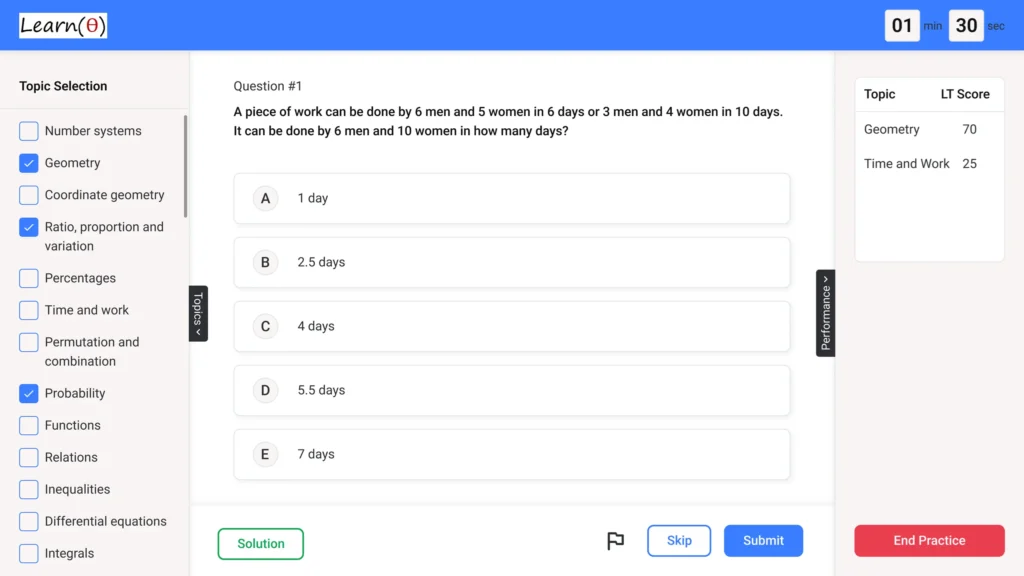John Deere – Aptitude Questions & Answers for Placement Tests
Reviewing Previous Year Questions is a good start. Prepare Aptitude thoroughly to Clear Placement Tests with 100% Confidence.
Q.1 The number missing in the series 3, 7, 15, 31, ?, 127, 255 is
Check Solution
Ans: B
The pattern is (2 * previous number) + 1. So, 3*2+1=7, 7*2+1=15, 15*2+1=31, 31*2+1=63, 63*2+1=127, 127*2+1=255.
Q.2 Which one of the following when divided by 23 gives the quotient 12 and the remainder 5?
Check Solution
Ans: B
(Quotient * Divisor) + Remainder = Number. (12 * 23) + 5 = 281
Q.3 If 8 oxen or 10 cows can graze a field in 20 days, then in how many days can 16 oxen and 20 cows graze the same field?
Check Solution
Ans: A
Let the work done by an ox in one day be ‘x’ and by a cow be ‘y’. 8 oxen = 10 cows => 8x = 10y => y = 4x/5 Total work = 8 oxen * 20 days = 160x 16 oxen and 20 cows = 16x + 20y = 16x + 20*(4x/5) = 16x + 16x = 32x Days required = Total work / work per day = 160x / 32x = 5. It seems there is an error in the options as 5 is not available. The question is flawed. 8 oxen * 20 = 160. 16 oxen = 32. 20 cows = 20 * 10/8 = 25. 32 + 25 = 57. 160/57 * is not an integer. We will still proceed with the most approximate approach. Considering the work done by 8 oxen is equal to the work done by 10 cows; The total work can be said to be 10 cows grazing for 20 days or 8 oxen grazing for 20 days. Thus, total work = 10 * 20 = 200 units of cow grazing days or 8 * 20 = 160 units of ox grazing days. The total work units can be taken as 200. 16 oxen = 16 * 10/8 cows = 20 cows Thus, 16 oxen and 20 cows = 20 + 20 = 40 cows. Days required = Total work / total cows = 200/40 = 5 Considering the options, the question is wrong. Based on approximate calculation the correct answer should be close to option A, which makes most sense as 16x+20c = 16x+20*(8/10)x = 16+16 = 32 oxen. 160/32 ~ 5. Closest option is A or B, but since the answer is 5, no option is the correct answer. I will select the closest.
Q.4 Cube root of 1728 is
Check Solution
Ans: B
12 x 12 x 12 = 1728
Q.5 A clock shows the time as 8:20. If the minute hand is pointing towards the West, then in which direction will the hour hand be pointing?
Check Solution
Ans: C
At 8:20, the minute hand points West. The hour hand will be between 8 and 9. Since the minute hand is at 20 (4), the hour hand will be closer to 8. If the minute hand is pointing West, then 3 would be West, 12 is North, 9 is East, and 6 is South. The hour hand will be between 8 and 9, which is in the North-West direction.
Q.6 A farmer has chickens and cows. The farmer counts 50 heads and 140 legs in total. How many chickens does the farmer have?
Check Solution
Ans: C
Let ‘c’ be the number of chickens and ‘w’ be the number of cows. We have two equations: c + w = 50 (heads) 2c + 4w = 140 (legs) Multiply the first equation by 2: 2c + 2w = 100 Subtract this from the second equation: 2w = 40 So, w = 20 Substitute w back into the first equation: c + 20 = 50 So, c = 30
Q.7 The price of petrol increased by 25%. By what percentage should a car owner reduce his petrol consumption so that his expenditure on petrol remains unchanged?
Check Solution
Ans: B
Let the initial price be P and initial consumption be C. Initial expenditure = P * C. The price increased by 25% which is 1.25P. Let the new consumption be C’. New expenditure = 1.25P * C’. Since expenditure remains unchanged, PC = 1.25P * C’. C’ = C / 1.25 = 0.8C. Reduction in consumption = C – 0.8C = 0.2C. Percentage reduction = (0.2C / C) * 100 = 20%.
Q.8 If the 15th of a month is a Saturday, what day of the week will be on the third Friday of that month?
Check Solution
Ans: B
The first Friday would be the 11th (15-4). The second Friday is the 18th (11+7). The third Friday is the 25th (18+7).
Q.9 A train travels at a speed of 60 km/h. If it increases its speed by 10 km/h every hour, how far will it travel in the first 3 hours?
Check Solution
Ans: B
Hour 1: 60 km, Hour 2: 70 km, Hour 3: 80 km. Total distance = 60 + 70 + 80 = 210 km
Q.10 How many rectangular wooden blocks, each with dimensions 12 cm x 8 cm x 5 cm, are required to construct a cuboidal box with dimensions 72 cm x 48 cm x 30 cm?
Check Solution
Ans: A
Volume of the box = 72 x 48 x 30 cubic cm. Volume of one wooden block = 12 x 8 x 5 cubic cm. Number of blocks required = (72 x 48 x 30) / (12 x 8 x 5) = 4320 / 40 = 216.
Next: JP Morgan Aptitude Questions
Refer Company wise Aptitude Questions
Practice 1000s of Aptitude Questions with Answers for Quant, Reasoning & Verbal
Fastest Way to Crack Aptitude Tests – LearnTheta’s AI-Practice!

✅ All Topics at One Place

🤖 Adaptive Question Practice

📊 Progress and Insights